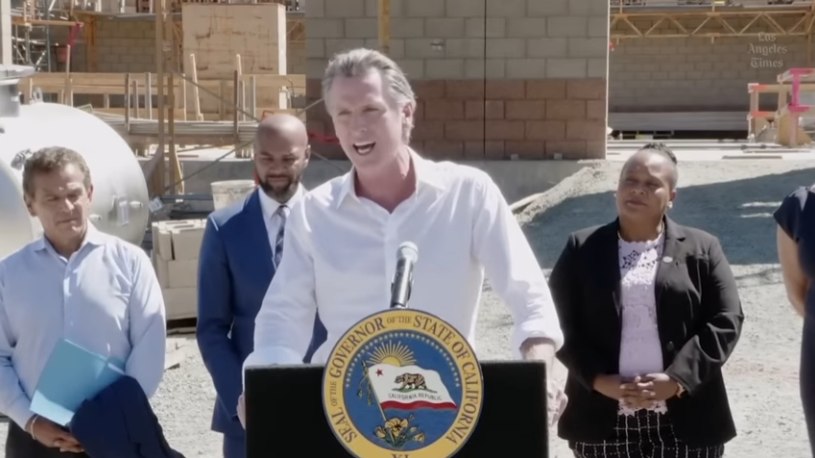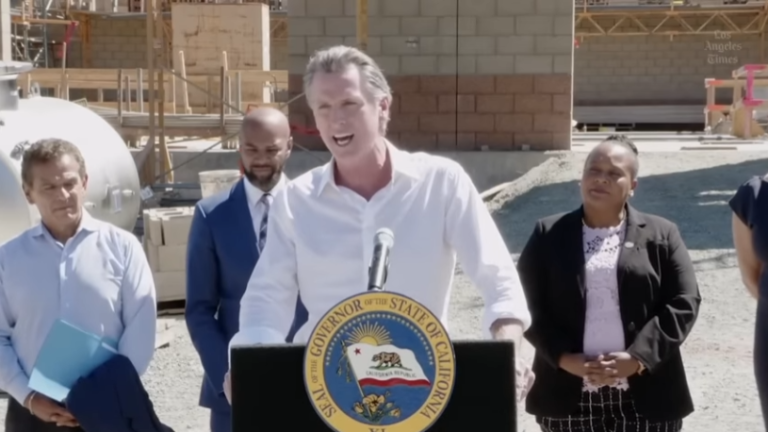With California enduring historic drought amplified by global warming, Gov. Gavin Newsom on Thursday released a new plan to adapt to the state’s hotter, drier future by capturing and storing more water, recycling more wastewater and desalinating seawater and salty groundwater.
The governor’s new water-supply strategy, detailed in a 16-page document, lays out a series of actions aimed at preparing the state for an estimated 10% decrease in California’s water supply by 2040 because of higher temperatures and decreased runoff. The plan focuses on accelerating infrastructure projects, boosting conservation and upgrading the state’s water system to keep up with the increasing pace of climate change.
“The hots are getting a lot hotter. The dries are getting a lot drier,” Newsom said. “We have to adapt to that new reality, and we have to change our approach.”
Newsom called it “an aggressive plan to rebuild the way we source, store and deliver water.”
Newsom spoke about the plan in Antioch, where a desalination plant is being built to treat brackish water.
Newsom also announced the appointment of former Los Angeles Mayor Antonio Villaraigosa, a former gubernatorial rival, as his new infrastructure czar.
The state plan calls for expanding water storage capacity above and below ground by 4 million acre-feet; expanding groundwater recharge; accelerating wastewater recycling projects; building projects to capture more runoff during storms, and investing in desalination of ocean water and salty groundwater.
The projected loss of 10% of the state’s water supply within two decades translates to losing 6 million to 9 million acre-feet per year on average — more than the volume of Shasta Lake, the state’s largest reservoir, which holds 4.5 million acre-feet.
“Mother Nature is still bountiful,” Newsom said. “But she’s not operating like she did 50 years ago. Hell, she’s not operating like she did 10 years ago. And we have to reconcile that.”
The state’s plan refers to how warmer temperatures unleashed by rising levels of greenhouse gases are leading to what many scientists describe as aridification. The warmer climate makes the atmosphere “thirstier,” pulling more moisture from the landscape through evaporation and increasing the amount plants take in, leaving less runoff flowing into streams and rivers.
“Regardless of drought or flood, in this changed climate there will be less water available for people to use,” the state plan says. “To match the pace of climate change, California must move smarter and faster to update our water systems.”
The plan was praised by representatives of water agencies and the agriculture industry. It drew criticism from researchers and environmental advocates, who said that although they agree with the focus on climate change, the measures fail to address agriculture, which consumes the largest share of California’s water,or make substantial changes to benefit the environment.
“The thrust of the report, to increase urgency and attention around recycling, urban stormwater capture, efficiency, those are all good things,” said Kate Poole, senior director of the Natural Resources Defense Council’s nature program. “That said, it’s really the things that aren’t in there that are most concerning. Agriculture obviously uses 80% of our developed water supply in California. So you can’t really deal effectively with water use without dealing with Big Ag. And Newsom does not seem very willing to do that.”
Poole said the state plan “doesn’t fundamentally change the direction of water management, which is needed to really grapple with climate change.”
The governor’s strategy calls for moving ahead with controversial plans to build a giant water tunnel beneath the Sacramento-San Joaquin River Delta, and accelerating projects such as the proposed Sites Reservoir, which would flood a valley north of Sacramento.
Poole said that building more storage generally means taking more water from the environment, and scientific reports have shown that California should significantly reduce water diversions from the Delta watershed to protect the environment, fisheries and water quality.
She also said the targets for wastewater recycling fall far short of state goals that were developed in 2019.
The plan says the extreme dryness and high temperatures during the 2012-16 drought, closely followed by the current drought since 2020, “send a strong climate signal that we must heed.”
Newsom said the shifts in California’s hydrology and the latest science on the aridification of the West have given his administration a “renewed sense of urgency to address this issue head-on.”
“What we’re focused on is creating more water,” Newsom said, adding that the effort includes projects like the new brackish water desalination plant in Antioch, which will pull water from the Delta.
California has 14 seawater desalination plants and 23 plants that turn brackish water into drinking water, Newsom said, and the state needs to be more aggressive in promoting desalination technology. The plan calls for finding locations for seawater desalination plants “where they are cost effective and environmentally appropriate.”
Newsom referred to the California Coastal Commission’s recent decision to reject a proposal for a large desalination plant in Huntington Beach, saying the commission will consider other smaller proposals, “and I expect to see a different result.”
The governor stressed that desalination is one part of a multifaceted approach that California needs — a “one water” approach — that also includes solutions from reusing water to capturing rainwater instead of letting it flow in drains toward the ocean.
The governor said Californians need to move “away from a scarcity mind-set to one more of abundance.”
“How can we take the existing resources and be more resourceful?” Newsom said.
The plan calls for completing seven water storage projects with about $2.7 billion from Proposition 1, the 2014 water bond: four groundwater storage projects and three reservoir projects.
Newsom expressed frustration about delays in projects because of permitting requirements, calling the years-long timelines “absurd” and “comedic.” One of the administration’s goals is to change permitting to “address the regulatory thickets” and fast-track needed water projects, he said.
“We need to accelerate our efforts. We need to double down,” Newsom said. “We can’t do the same damn thing anymore. And I think all of us recognize that.”
The plan includes targets and timelines, such as expanding desalination of brackish groundwater to 84,000 acre-feet by 2040, and boosting the state’s capacity to capture storm water by 500,000 acre-feet by 2040. For comparison, the total annual water use of Los Angeles is nearly 500,000 acre-feet.
Among other things, the plan calls for creating a groundwater recharge coordinating committee to help implement projects that will replenish aquifers.
To offset the increased evaporation and reduction in supplies brought on by the changing climate, the plan says, “California must capture, recycle, de-salt, and conserve more water.”
The plan cites progress in ensuring clean drinking water, saying that the estimated number of Californians with contaminated, failing drinking water systems has decreased from 1.6 million to 934,000. The state’s record in finding solutions for these communities, many in low-income, rural areas, drew criticism in a recent state auditor report, which found the State Water Resources Control board has funding available but has “demonstrated a lack of urgency in providing this critical assistance.”
The plan calls for boosting conservation in cities and reducing water use by at least 500,000 acre-feet by 2030. But Poole and others noted that for agriculture, the document says the goal is to “stabilize” water supplies while California’s groundwater law is gradually implemented between now and 2040, bringing an eventual reduction in the amount of irrigated farmland.
Although the focus on climate change is positive, the plan doesn’t really address “major problems for the state in terms of water management,” said Jay Lund, co-director of the UC Davis Center for Watershed Sciences. One of those issues, he said, is the projection that Central Valley growers will eventually be forced to leave fallow at least 1 million acres of irrigated land.
“We’ve got to find like 20% agricultural water conservation for sure, as a base, just to compensate for groundwater overdraft and a little bit of climate change,” Lund said. “That’s the elephant in the room, is how do you help those poor rural areas that are going to have to reduce their agricultural water use by millions of acre-feet? And what can the state do to help them?”
There is also very little in the plan on ecosystems, Lund said, which is “probably the biggest gap.”
The plan calls for modernizing the administration of water rights by digitizing paper records and improving data, among other things. Poole argued that the Newsom administration should instead modernize the antiquated water rights system “to prioritize water for people’s personal use and the environment over ag.”
Newsom said the plan, which builds on a water resilience portfolio released in 2020, details a set of solutions with specific timelines and goals. The governor noted that he and the Legislature have earmarked more than $8 billion over the last three years for water infrastructure and management.
In his new role, Villaraigosa will draw on available federal resources for water infrastructure projects, Newsom said. He will serve as the primary state liaison for local and elected officials on infrastructure needs, conducting meetings with regional and federal leaders, according to the governor’s office.
Newsom’s naming of Villaraigosa as a state infrastructure advisor follows a period of heated rivalry between the two politicians. In 2018, Villaraigosa mounted the strongest intraparty challenge to Newsom, whom he accused of “selling snake oil.”
During his time as L.A. mayor, Villaraigosa expanded mass transit as well as the size of the LAPD. He’s currently a partner in the consulting firm Actum.
In his new position, Villaraigosa will not be a state employee. Instead, the position will be supported through a partnership with the nonprofit California Forward.
Times staff writer Taryn Luna in Sacramento contributed reporting.
Source: latimes.com



